The Healing Process Model.
Dance on Top of the World by Pascale Archambault - 1999
This sculpture featured on the cover of the book represents the silhouettes of children through and on top of a granite wall. It is located in Montreal’s Mt. Royal Cemetery at the Children’s Memorial Garden. It was developed to offer child-sized graves near the sculpture. The authors thank the artist for allowing them to feature it on the cover.
“I create this work for the poeple
left behind, a peaceful reminder of
the children who are no longer with
us in body but whose love remains.”
Pascal Archambault

The grief associated with such reproductive losses could be minimized, denied, or considered to be outside the normal "grieving rules" of society. Yet individuals who have suffered these losses can experience profound grief and emotional pain. Their grief needs to be acknowledged by themselves and by others.
Grieving Reproductive Loss: The Healing Process acknowledges the devastating impact these losses can have. Written in "plain language," the book attempts to bring about a greater understanding of the grief associated with reproductive loss and, through The Healing Process Model©, offers a holistic approach for constructive, healthy grieving and healing of body, mind, and spirit.
The Healing Process Model© is especially helpful for individuals who have suffered a reproductive loss because it is derived from their experiences of loss and grief and differs from some existing models of grief developed in studies of widows and widowers.
Bereaved parents present a special challenge due to the uniqueness of parental grief: they have experienced not only a reproductive loss and the tragic death of a child, but also the loss of part of themselves, the loss of a future life with that child, and the loss of hopes and dreams. The guidelines of The Healing Process Model© can be used for recognizing, acknowledging, and intervening in reproductive loss by the bereaved themselves, by friends and family of the bereaved, and by health care providers, whether or not trained in grief care.
Contents.
The book includes chapters on:
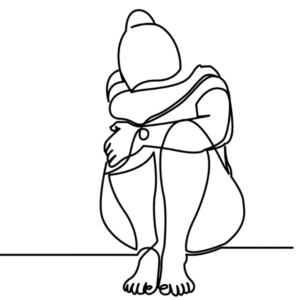
Grief

The body-mind-spirit connection
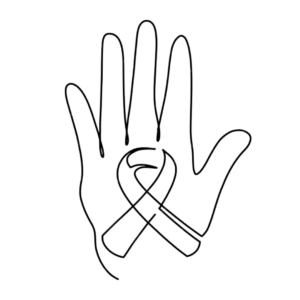
Relating Worden's Tasks
of Mourning to
reproductive loss

Facilitating the Healing
Process Model

Obstacles to grieving

Issues related to
reproductive loss
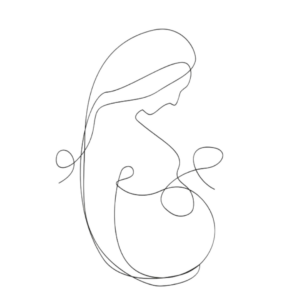
Types of reproductive loss
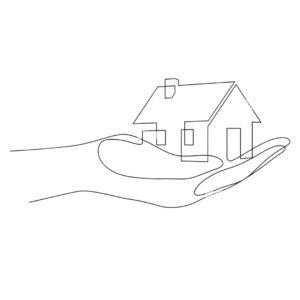
Reproductive loss
as a family affair

Establishing support groups

Caring for oneself while
caring for the bereaved
“Grief is like the ocean. It comes on waves
ebbing and flowing. Sometimes the water
is calm, and sometimes it is overwhelming.
All we can do is learn to swim.”
Vicki Harrison
About the authors
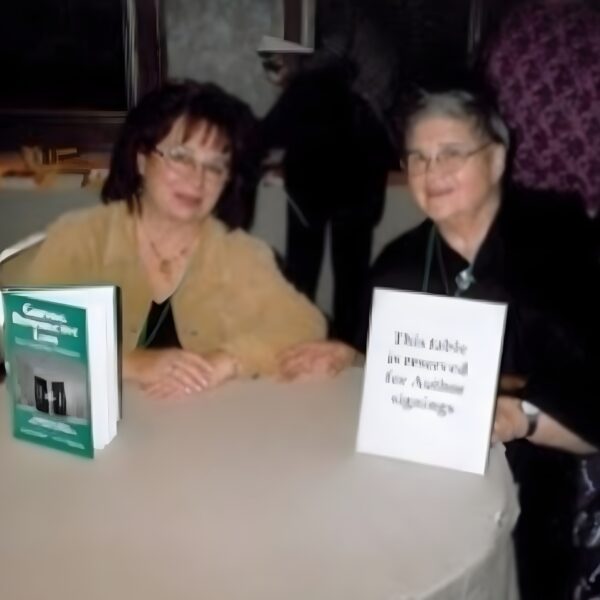
Kathleen Gray (left), RN, MSN, MEd, is a registered nurse and bereavement counselor. She obtained her undergraduate degree in nursing from Nazareth College, Rochester, New York, a Master of Science in Nursing from The Catholic University of America, Washington, D.C., and a Master of Education in Counseling Psychology from McGill University, Montreal. Ms. Gray also studied psychology at the Alder Institute in Montreal and Chicago. After several years of nursing and university teaching, she was drawn to the area of grief and bereavement, especially as it concerns the loss of a child due to reproductive-related conditions. This led to her founding of the Centre for Reproductive Loss, where she served as director, and since 2024 as board member. Ms Gray has presented conference papers in Canada and the United States and was a contributing author in Men Coping with Grief (Dale A. Lund, ed., Baywood, 2001).
Anne Lassance (right), RN, MEd, is a graduate of Mercy Hospital School of Nursing, Iowa, and acquired her bachelor’s degree from Clarke College, Iowa, and a Master of Education with a Major in Nursing from the University of Minnesota. She also studied public health at Marquette University, Wisconsin. Formerly, assisstant professor of nursing at McGill University, Ms. Lassance was co-founder of the Centre for Reproductive Loss, where she served as assistant director and bereavement counselor.
Anne passed away on November 5th of 2020. Her dedicated work to the CRL and passionate empathy contributed profoundly to ameliorating the lives of bereaved individuals. She leaves behind a nurtured legacy, not only in their written work but also in the lives she has touched and the hearts she gave hope to.
The Healing Process Model©
Grief associated with reproductive loss can be extremely painful and distressing, affecting an individual’s body, mind, and spiritual well-being.
Derived from clinical observations of the actual experiences of bereaved individuals who suffered a reproductive loss, Kathleen Gray and Anne Lassance developed a clinical based model, the Healing Process Model ©, which offers a holistic approach for constructive, healthy grieving, and healing of the body, mind and spirit. It differs from some existing models of grief developed in studies of widows and widowers because the grief experience after reproductive loss is a unique challenge for individuals who experience reproductive loss and their caregivers. In the book titled, Grieving Reproductive Loss:The Healing Process, the authors examine such losses and explain how through the Healing Process Model © , a healing response can be elicited in the treatment of reproductive loss.
The Healing Process Model© is adapted to recognize the unique grieving and healing process of each individual, respecting where the individual is in his or her healing journey, through compassion and nonjudgmental listening. It does not follow a step by step model, but rather progresses from cues from the individual who is bereaved.
The objective is to heal, comfort, soothe, grow sound again, encourage, restore, and renew the body, mind, and spirit of those who grieve and mourn by following the operations or actions of the Outline of the Healing Process Model © Some of the operations or actions of the process are those of the bereaved, while some are the actions of the caregiver or counselor.
The Healing Process Model© Outline.
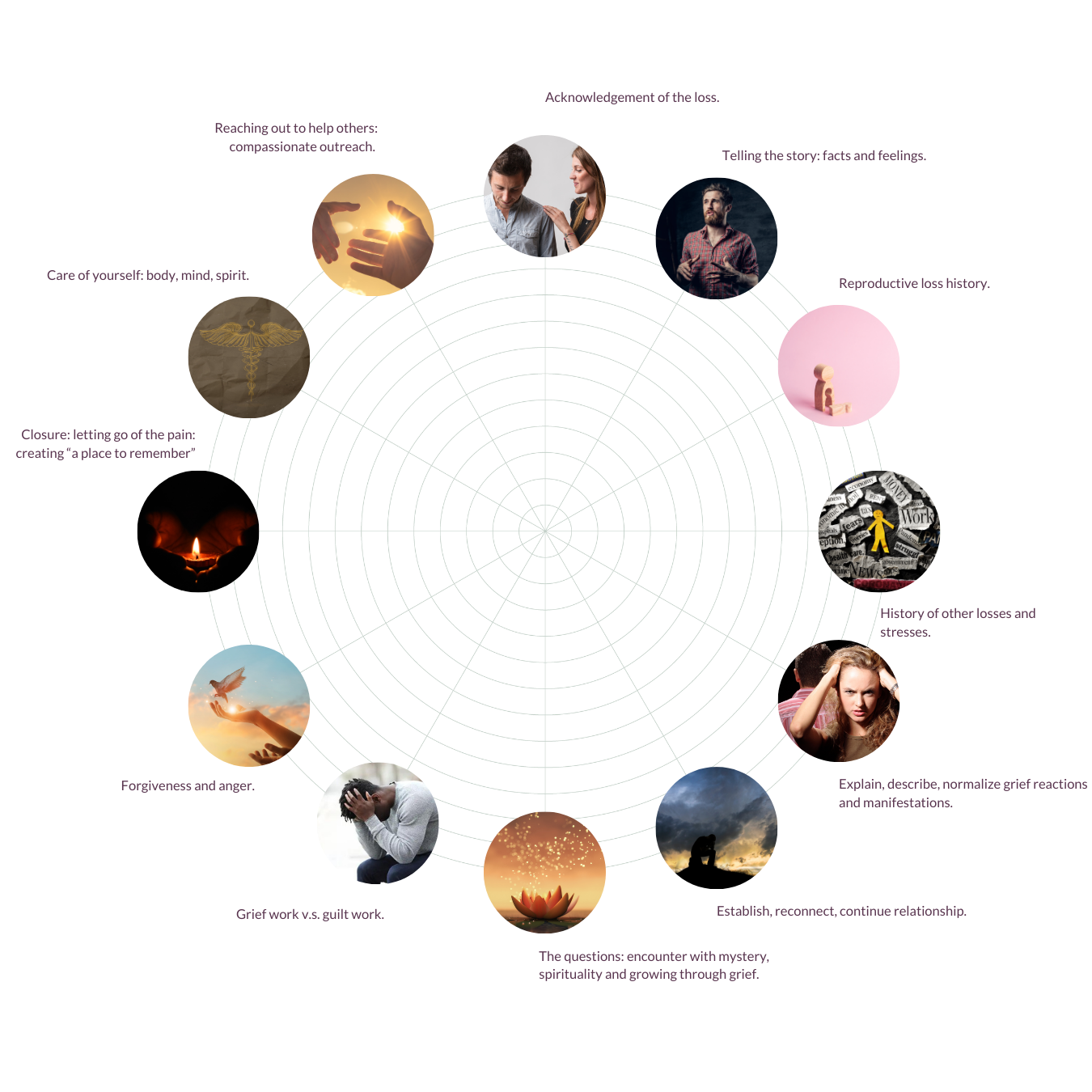
In praise of
"As a member of the perinatal bereavement team at St. Mary's Hospital Centre, I am only too aware of how misunderstood is the grief involved in reproductive loss. The good news is that Montrealers Kathleen Gray and Anne Lassance have written a very comprehensive, sensitive book that can help families deal with this difficult issue. Grieving Reproductive Loss is 196 pages of excellent information for friends and families of the bereaved as well as for healthcare practitioners. I would strongly recommend this book to all health-care practitioners who work with clients affected by reproductive loss. I would also recommend it to anyone who is interested in understanding this topic further or the concept of grief in general."
Cindy Morneault
Director of Pastoral and Spiritual Services
St. Mary's Hospital Centre
The Catholic Times, January 2004
"I found this book quite enlightening and clearly represents considerable advance concerning bereavement in the aftermath of reproductive loss. The authors are to be lauded for their efforts to fill a void in the literature by not only articulating issues related to reproductive loss but also outlining a healing process model specific to the unique grief experience following reproductive loss."
Mark Lukas
Ed.D., CT
"This very readable and timely book will appeal to all health professionals as well as to the bereaved and their families. Written by two experienced practitioners, it provides theoretical and practical information that is invaluable for appreciating the legitimacy of the process of mourning a reproductive loss."
Evelyn Adam
RN, MN
Professor Emeritus
Université de Montréal
"The extent of the grief due to pregnancy loss can be marked as I have observed, even when the loss of this new member occurs within the first trimester. This book from Gray and Lassance is a much needed and valuable contribution to the understanding of and coping with reproductive loss, as it relates their experience as practitioners in this field."
Reverend Louis Lussier
OSCam, MDiv, MD, PHD
"This book speaks powerfully of the suffering long known by adults seeking the world of the parent, but often ignored, minimized or discarded by the world and the professionals who provide care. This book will serve well."
The Rev. Richard B. Gilbert
BCC, CT, Ph.D.
Resources Hotline, Volume 6, Number 6
"Some of our most profound suffering as human beings is produced by the loss of relationships with others. The grief engendered is most severe and harmful when the loss is denied, as can happen with reproductive loss. Kathleen Gary and Anne Lassance explore such loss and illustrate how a healing response to it can be elicited in individuals, those who care for them - whether in a personal or professional capacity - and society. Grieving Reproductive Loss will provide people who experience such loss, and those who seek to help them, with much needed suffering - and - harm - reduction approaches."
Margaret A. Somerville
AM, FRSC
Professor, Faulty of Medicine
McGill Centre for Medicine, Ethics and Law
"Grieving Reproductive Loss is a timely addition to the literature on grieving. The Healing Process Model provides a template useful in the evaluation and effective holistic treatment of grief, including the important area of spiritual healing, and is especially helpful for clinicians who often deal with questions of loss."
Richard Haber
MD, FRCP, FAAP
Fellow of the Royal College of Physicians and Surgeons of Canada
Fellow of the American Academy of Pediatrics
"Grieving Reproductive Loss is a valuable and timeless book dedicated “to all those who grieve the loss of a child.” Its focus is on loss of a child due to reproductive-related conditions such as miscarriage, abortion, and still-birth, as well as post-natal death due to medical abnormalities or sudden infant death syndrome (SIDS). But as someone whose daughter died in young adulthood, I can attest to the value of this book for anyone who has lost a child, even children older than infancy. Based on their extensive counseling experience, Gray and Lassance created this book for two types of audiences – both grieving parents and also those who counsel and/or support them. The book is thoroughly researched and referenced, is very empathetic, very practical, and I found that it addressed every aspect of the grief process that I went through. Grieving Reproductive Loss normalizes what parents go through, and helps friends and relatives to support parents through their mourning journey, no matter how long it is. I highly recommend this book."
Jennifer P. Schneider
M.D., Ph.D.
University of Arizona College of Medicine
A story of healing.
Mary's Story.
Dear Mrs. Gray,
As I read your book, I recognized myself in so many ways. I realized that I needed to do my own grief work. I realized that the “triggers” were a normal part of grieving and not something, which I kept telling myself I should be over. For me, the letter writing was an inspiration, helping me to release what I had been feeling. It gave me a place to store those feelings and thoughts, without having to keep them inside. I learnt so much about the grieving process for myself and others.Secondly, our family was touched by a reproductive loss. In 1988, I got married and a new relationship began with my mother. She started talking to me about things she had never discussed before; things that traditional European women only talked about amongst married women. In the course of a conversation one day, tears began to pour down her eyes and she told me about, Steven, my brother, a stillborn baby she’d had, in 1962, a year and half before my birth. She cried and cried, telling me that since the first few months after his birth, she had never talked to anyone again about Steven. You can imagine my shock and surprise, realizing that I’d had a brother that I knew nothing about. I couldn’t imagine the pain my mother had gone through holding that in for 26 years.
It seemed like a relief to her to have someone to talk to about Steven. For months thereafter, she mentioned Steven almost every time we had a conversation. I knew that she needed to talk and I was so willing to listen, to learn about a side of mother that I had never known. My mother was a Portuguese immigrant with very limited English and French skills back in 1962. It was a time when men didn’t go to the delivery room and the nurses thought that it was best for the mother not to see her stillborn child. She talked about the anguish of not knowing what Steven looked like, of never holding him, of seeing him in her dreams. She talked about how the doctor had seemed so cold, how she’d had to endure listening to the other babies’ cries until she finally found a nurse who spoke Portuguese to whom she was able to ask to please move her from the baby ward. We cried together as she spoke of the enormous sense of disbelief and her feelings of helplessness.
She spoke of temporarily hating her co-workers in the textile plant for not talking to her about her baby. Her thoughts were, “I had a baby! Why won’t you talk about him?” She eventually came to the realization that they were only trying to be sensitive and not bring her pain, but at that time, she didn’t see it that way. She was missing the acknowledgement.
The one thing that struck me most, in all of her conversations, was that she kept saying, she wished she knew where my brother was buried. She had received a $4.00 bill for his burial, but not being able to speak the language, she couldn’t trace where he was. That little bill, sat in a little locked metal box under my mother’s bed. A box that had always peeked the curiosity of my two sisters and I, but that we never dared to ask about (we knew not to). One day she pulled out that little box and let me see the bill. The bill had come from St. Jerome’s Hotel Dieu Hospital, with the details of the burial of a child, born November 29, 1962. This was the only thing my mother had left of Steven. My dad, thinking that it would help, had removed all the clothes and furnishing for Steven from the house before my mom had come home from the hospital. At the time, to her, it felt like everyone wanted to erase Steven’s existence.
That same day, I was at the cemetery and again, was impressed by human kindness. The caretaker of the cemetery took me to where Steven would have been buried. It was in a tiny strip of grass with other little babies who had been buried. It was the most beautiful strip of grass I’d ever seen; brown, tattered cut grass, but beautiful in my eyes.
Next came preparation work, before telling my mother. I ordered a small tombstone for baby Steven because I knew it would break my mom’s heart to see the plot without a stone (a secret gift from me to her). Once installed, the moment to tell her came. I was swept with emotions, unsure of if I was doing the right thing. One day I said, “If I knew where Steven was buried, would you want to know?” The bright woman my mother is, broke out in tears. She knew that I knew. We went up the cemetery that day and the look on her face, when she stopped crying, told me I had done the right thing. She has mentioned to me that knowing where he’s buried, gave her closure. She knows that he has a spot. It gave her “a place to remember”. Now, when she talks about Steven, she barely ever cries, she smiles. (Just as a note: she also gave herself permission to tell everyone in the family about Steven.)
As I read your book, the reality of how much my mother must have gone through, alone in her pain, set in. I knew she’d gone through much pain, but the book gave me a new understanding of that pain. I learnt so much through your experiences with the bereaved and their experiences.
Lastly, this book has been a precursor to a course I am taking. I am taking the Pastoral Home Care Formation from the Archdiocese of Montreal. I can’t tell you how often the two have tied hand in hand. The Healing Process Model© can criss-cross with so many other experiences, not only with reproductive loss. The need to acknowledge, to listen, to understand past experiences, to honour life, death, and spirituality, to encourage healing are just a few of the areas where pastoral home care and healing from reproductive loss are similar. It made me realize, too, that I should read about grieving a spouse, so I may understand that better, as well, for those whom I visit. I honestly believe that I will be a better Pastoral Home Care minister because of your book, especially since it has helped me to continue on my own healing journey.
Thank-you so much, Kathleen!
Sincerely,
Mary C.
Contact Us
PO Box 55025Montréal CP Belmore, QC, H4V 0A1
info@beta.crl-rho.org
https://beta.crl-rho.org
CENTRE FOR
REPRODUCTIVE LOSS
All the information published on this website, or in any article herein is true and accurate to the best of the authors' knowledge.
Information on this site is a resource only and should not be a substitute for medical advice. No liability is assumed by the Centre for Reproductive Loss, employees, and volunteers,
for losses suffered by any person or organization relying directly or indirectly on information published on this site. Views expressed in any article are the views of the authors.
Information appearing on this site may be reproduced with credit being given to the source. © Centre for Reproductive Loss
Copyright © 2025 - Centre for Reproductive Loss (CRL - RHO) - All Right Reserved | Designed by Jojomasu Inc.

